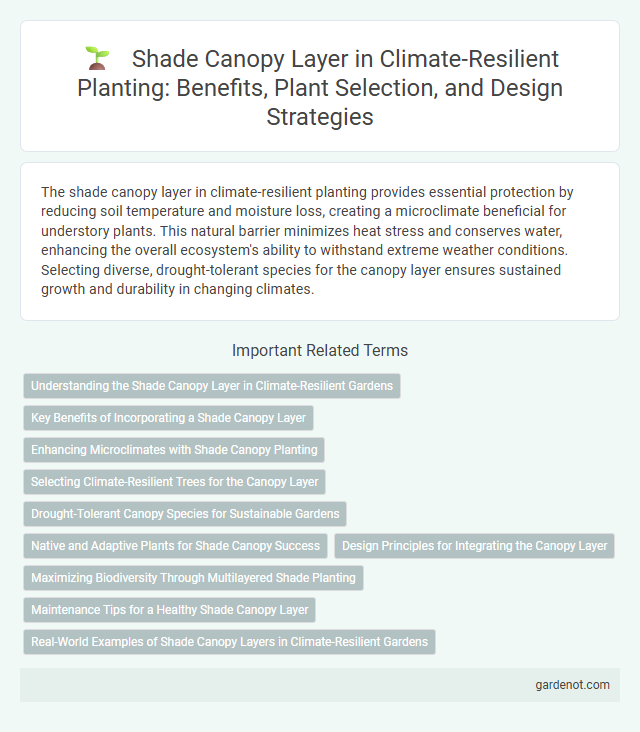The shade canopy layer in climate-resilient planting provides essential protection by reducing soil temperature and moisture loss, creating a microclimate beneficial for understory plants. This natural barrier minimizes heat stress and conserves water, enhancing the overall ecosystem's ability to withstand extreme weather conditions. Selecting diverse, drought-tolerant species for the canopy layer ensures sustained growth and durability in changing climates.
Understanding the Shade Canopy Layer in Climate-Resilient Gardens
The shade canopy layer in climate-resilient gardens plays a crucial role in reducing soil temperature and conserving moisture, which enhances plant survival during heatwaves and droughts. This layer, typically formed by tall trees or large shrubs, filters sunlight, creating a microclimate that protects understory plants from extreme weather conditions. Incorporating diverse native species in the canopy improves ecosystem stability and supports biodiversity, vital for adapting to climate variability.
Key Benefits of Incorporating a Shade Canopy Layer
Incorporating a shade canopy layer enhances microclimate regulation by reducing soil temperature and moisture evaporation, promoting healthier plant growth and water conservation. This layer also supports biodiversity by providing habitat and food sources for various species, contributing to ecosystem stability. Furthermore, a shade canopy mitigates the impacts of extreme weather events, increasing overall climate resilience in agricultural and natural landscapes.
Enhancing Microclimates with Shade Canopy Planting
Shade canopy planting improves microclimates by reducing soil temperature and moisture evaporation, creating a cooler and more humid environment essential for climate resilience. Trees with broad, dense canopies intercept solar radiation, protecting understory plants from heat stress and conserving water resources during droughts. Incorporating diverse shade species enhances biodiversity while stabilizing microclimatic conditions, promoting ecosystem health in climate-sensitive regions.
Selecting Climate-Resilient Trees for the Canopy Layer
Selecting climate-resilient trees for the shade canopy layer involves prioritizing species with high drought tolerance, pest resistance, and adaptability to temperature fluctuations commonly found in shifting climates. Native trees like Quercus rubra (Northern Red Oak) and Acer saccharum (Sugar Maple) demonstrate strong resilience and support local biodiversity while providing optimal shade coverage. Incorporating genetically diverse specimens enhances the overall durability of the canopy, ensuring long-term sustainability in urban and rural planting initiatives.
Drought-Tolerant Canopy Species for Sustainable Gardens
Drought-tolerant canopy species such as Acacia, Quercus ilex, and Prosopis provide essential shade and reduce water evaporation in climate-resilient gardens. These species enhance soil moisture retention, support local biodiversity, and improve microclimates to withstand prolonged dry periods. Selecting deep-rooted, drought-resistant trees promotes sustainable garden ecosystems with lower irrigation demands and increased resilience against climate stress.
Native and Adaptive Plants for Shade Canopy Success
Selecting native and adaptive plants for the shade canopy layer enhances climate resilience by supporting local biodiversity and improving ecosystem stability. Species such as Eastern Redbud (Cercis canadensis) and American Holly (Ilex opaca) thrive under varying climate conditions while providing critical shade and habitat for understory plants. Integrating these plants reduces maintenance needs and boosts long-term survival rates in climate-resilient landscapes.
Design Principles for Integrating the Canopy Layer
The shade canopy layer serves as a crucial component in climate-resilient planting, providing temperature regulation and moisture retention essential for ecosystem stability. Design principles emphasize selecting native, drought-tolerant tree species with deep root systems to enhance soil structure and prevent erosion. Strategic layering and spacing maximize light interception and biodiversity while supporting understory plants adapted to shade conditions.
Maximizing Biodiversity Through Multilayered Shade Planting
Integrating a multilayered shade canopy enhances climate resilience by supporting diverse microhabitats that promote rich biodiversity. Species such as native hardwoods, fruit trees, and understory shrubs create stratified foliage layers critical for wildlife habitats and soil health. This vertical complexity improves ecosystem services like carbon sequestration, temperature regulation, and pest control crucial for sustainable agroforestry systems.
Maintenance Tips for a Healthy Shade Canopy Layer
Regular pruning and removal of dead or diseased branches enhance airflow and light penetration in the shade canopy layer, promoting healthy growth. Mulching around the base regulates soil moisture and temperature, reducing stress on shade trees. Monitoring for pests and diseases early ensures timely intervention, maintaining the resilience and functionality of the shade canopy in climate-resilient planting systems.
Real-World Examples of Shade Canopy Layers in Climate-Resilient Gardens
Climate-resilient gardens incorporate shade canopy layers using species such as moringa and pigeon pea, which provide essential shelter and reduce soil temperature. Urban areas in Singapore utilize multi-tiered shade canopy designs to improve microclimates and enhance biodiversity. In agroforestry systems in Kenya, shade trees like grevillea protect understory crops from heat stress, increasing overall farm resilience to climate variability.
Shade canopy layer Infographic

 gardenot.com
gardenot.com